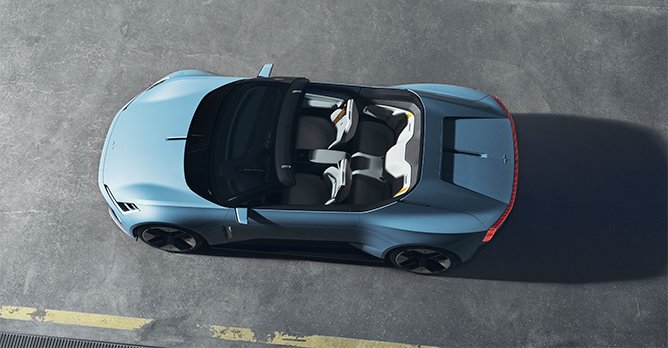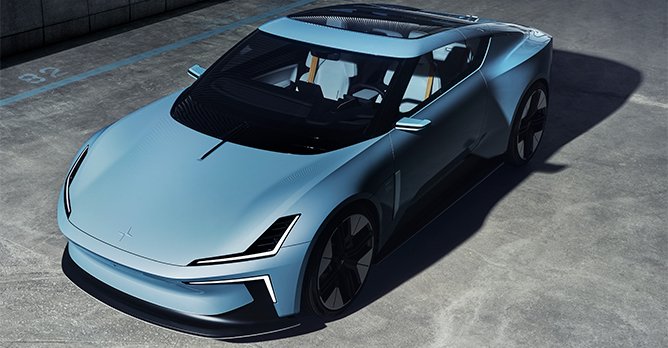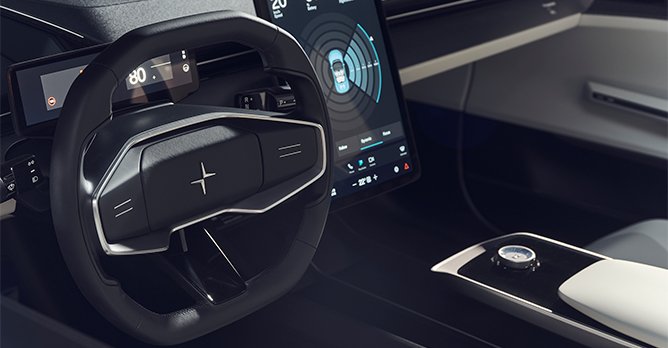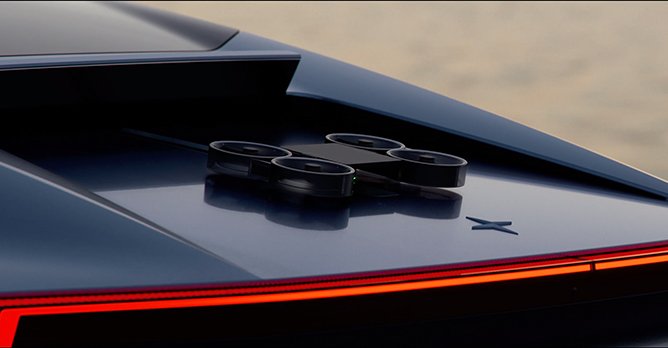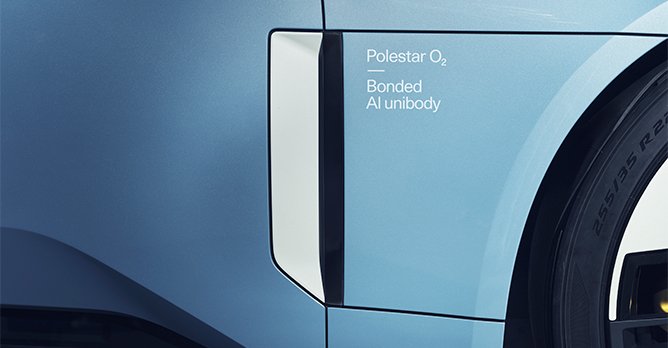Polestar's roadster concept promises a new era of electric performance
02 Mar 2022|352 views
Exciting things are happening at Polestar.
While its fastback sedan, the Polestar 2, was debuting to impressive sales and glowing reviews, the company announced an aggressive release strategy that would see three new models hitting the market within the next three years - one per year, starting with the Polestar 3 in 2022.
As such, the company's latest reveal of the Polestar O2 concept - a gorgeous electric roadster - is a somewhat unsurprising, although nonetheless stunning move.
Envisioned as a 2+2 hardtop convertible, Polestar is calling the O2 the 'hero car' of its brand, which will usher in a new era for sports cars by combining the thrills of open-top driving with the 'purity of electric mobility'.
The Precept-turned-Polestar 5 that we saw last year marked a slight pivot in terms of the firm's design language, as well as a sharpened approach to the company's ethos of sustainability and lightweight performance.
As the first follow-up after that, the O2 concept intentionally draws heavy reference; its front fascia wears the angular 'shark nose' that we first saw, while a similar uninterrupted, 'aero blade'-like light strip rounds off the rear.
Translating all that into the body of a roadster, however, naturally produces quite a different visual result, with the added air intakes, shorter wheelbase, as well as sloping roofline.
Underpinning the O2 concept as well is the same bonded aluminium architecture, which Polestar says promises groundbreaking torsional rigidity for superlative performance. The fact that it will work both on the grand-tourer Polestar 5, as well as something as purposefully performance-oriented as the O2 concept, also attests to its versatility and scalability.
Polestar is also doubling down on its shift towards more responsible manufacturing practices by streamlining the materials used for the car.
Aluminium used in the body of the O2 concept will be differentiated into various specified grades, which can then be recycled individually.
Meanwhile, the interior will feature a thermoplastic 'mono material', as well as recycled polyester as the sole material for all of the soft components. Such practices are ultimately targeted at increasing the potential of circling the same materials back into the chain of production, once the car has reached the end of its life cycle.
But perhaps most strikingly (and in line with the carmaker's streak of wild ideas thus far), the O2 concept features what Polestar calls a 'cinematic drone', which can take off autonomously from the car and follow it at speeds of up to 90km/h. Think of it as an integrated Mavic Pro.
This will apparently help to satisfy the desire of Polestar drivers to record the 'perfect driving sequence', with the option of different atmospheres as well.
Polestar's engineers have also clearly given the idea serious thought by developing an aerofoil that will be raised behind the rear seats when the drone is disembarking and returning to the car. Colour us intrigued.
Theoretical performance figures for the O2 concept remain unclear (they're not mentioned in the firm's press release). But if you've been a fan of Polestar - as we admittedly are - and have been watching closely, you'll know the Swedish company isn't the sort to just play around with a concept.
Or at least that's what we hope, given how the Precept design language continues to work visual magic. Given the O2 concept's focus on sustainability, will this be the firm's highly-hyped carbon neutral Polestar 0 car, set to launch in 2030? We'll look forward to our next cue if a follow-up press release is published with a 0-100km/h timing…
While its fastback sedan, the Polestar 2, was debuting to impressive sales and glowing reviews, the company announced an aggressive release strategy that would see three new models hitting the market within the next three years - one per year, starting with the Polestar 3 in 2022.
As such, the company's latest reveal of the Polestar O2 concept - a gorgeous electric roadster - is a somewhat unsurprising, although nonetheless stunning move.
Envisioned as a 2+2 hardtop convertible, Polestar is calling the O2 the 'hero car' of its brand, which will usher in a new era for sports cars by combining the thrills of open-top driving with the 'purity of electric mobility'.
The Precept-turned-Polestar 5 that we saw last year marked a slight pivot in terms of the firm's design language, as well as a sharpened approach to the company's ethos of sustainability and lightweight performance.
As the first follow-up after that, the O2 concept intentionally draws heavy reference; its front fascia wears the angular 'shark nose' that we first saw, while a similar uninterrupted, 'aero blade'-like light strip rounds off the rear.
Translating all that into the body of a roadster, however, naturally produces quite a different visual result, with the added air intakes, shorter wheelbase, as well as sloping roofline.
Underpinning the O2 concept as well is the same bonded aluminium architecture, which Polestar says promises groundbreaking torsional rigidity for superlative performance. The fact that it will work both on the grand-tourer Polestar 5, as well as something as purposefully performance-oriented as the O2 concept, also attests to its versatility and scalability.
Polestar is also doubling down on its shift towards more responsible manufacturing practices by streamlining the materials used for the car.
Aluminium used in the body of the O2 concept will be differentiated into various specified grades, which can then be recycled individually.
Meanwhile, the interior will feature a thermoplastic 'mono material', as well as recycled polyester as the sole material for all of the soft components. Such practices are ultimately targeted at increasing the potential of circling the same materials back into the chain of production, once the car has reached the end of its life cycle.
But perhaps most strikingly (and in line with the carmaker's streak of wild ideas thus far), the O2 concept features what Polestar calls a 'cinematic drone', which can take off autonomously from the car and follow it at speeds of up to 90km/h. Think of it as an integrated Mavic Pro.
This will apparently help to satisfy the desire of Polestar drivers to record the 'perfect driving sequence', with the option of different atmospheres as well.
Polestar's engineers have also clearly given the idea serious thought by developing an aerofoil that will be raised behind the rear seats when the drone is disembarking and returning to the car. Colour us intrigued.
Theoretical performance figures for the O2 concept remain unclear (they're not mentioned in the firm's press release). But if you've been a fan of Polestar - as we admittedly are - and have been watching closely, you'll know the Swedish company isn't the sort to just play around with a concept.
Or at least that's what we hope, given how the Precept design language continues to work visual magic. Given the O2 concept's focus on sustainability, will this be the firm's highly-hyped carbon neutral Polestar 0 car, set to launch in 2030? We'll look forward to our next cue if a follow-up press release is published with a 0-100km/h timing…
Exciting things are happening at Polestar.
While its fastback sedan, the Polestar 2, was debuting to impressive sales and glowing reviews, the company announced an aggressive release strategy that would see three new models hitting the market within the next three years - one per year, starting with the Polestar 3 in 2022.
As such, the company's latest reveal of the Polestar O2 concept - a gorgeous electric roadster - is a somewhat unsurprising, although nonetheless stunning move.
Envisioned as a 2+2 hardtop convertible, Polestar is calling the O2 the 'hero car' of its brand, which will usher in a new era for sports cars by combining the thrills of open-top driving with the 'purity of electric mobility'.
The Precept-turned-Polestar 5 that we saw last year marked a slight pivot in terms of the firm's design language, as well as a sharpened approach to the company's ethos of sustainability and lightweight performance.
As the first follow-up after that, the O2 concept intentionally draws heavy reference; its front fascia wears the angular 'shark nose' that we first saw, while a similar uninterrupted, 'aero blade'-like light strip rounds off the rear.
Translating all that into the body of a roadster, however, naturally produces quite a different visual result, with the added air intakes, shorter wheelbase, as well as sloping roofline.
Underpinning the O2 concept as well is the same bonded aluminium architecture, which Polestar says promises groundbreaking torsional rigidity for superlative performance. The fact that it will work both on the grand-tourer Polestar 5, as well as something as purposefully performance-oriented as the O2 concept, also attests to its versatility and scalability.
Polestar is also doubling down on its shift towards more responsible manufacturing practices by streamlining the materials used for the car.
Aluminium used in the body of the O2 concept will be differentiated into various specified grades, which can then be recycled individually.
Meanwhile, the interior will feature a thermoplastic 'mono material', as well as recycled polyester as the sole material for all of the soft components. Such practices are ultimately targeted at increasing the potential of circling the same materials back into the chain of production, once the car has reached the end of its life cycle.
But perhaps most strikingly (and in line with the carmaker's streak of wild ideas thus far), the O2 concept features what Polestar calls a 'cinematic drone', which can take off autonomously from the car and follow it at speeds of up to 90km/h. Think of it as an integrated Mavic Pro.
This will apparently help to satisfy the desire of Polestar drivers to record the 'perfect driving sequence', with the option of different atmospheres as well.
Polestar's engineers have also clearly given the idea serious thought by developing an aerofoil that will be raised behind the rear seats when the drone is disembarking and returning to the car. Colour us intrigued.
Theoretical performance figures for the O2 concept remain unclear (they're not mentioned in the firm's press release). But if you've been a fan of Polestar - as we admittedly are - and have been watching closely, you'll know the Swedish company isn't the sort to just play around with a concept.
Or at least that's what we hope, given how the Precept design language continues to work visual magic. Given the O2 concept's focus on sustainability, will this be the firm's highly-hyped carbon neutral Polestar 0 car, set to launch in 2030? We'll look forward to our next cue if a follow-up press release is published with a 0-100km/h timing…
While its fastback sedan, the Polestar 2, was debuting to impressive sales and glowing reviews, the company announced an aggressive release strategy that would see three new models hitting the market within the next three years - one per year, starting with the Polestar 3 in 2022.
As such, the company's latest reveal of the Polestar O2 concept - a gorgeous electric roadster - is a somewhat unsurprising, although nonetheless stunning move.
Envisioned as a 2+2 hardtop convertible, Polestar is calling the O2 the 'hero car' of its brand, which will usher in a new era for sports cars by combining the thrills of open-top driving with the 'purity of electric mobility'.
The Precept-turned-Polestar 5 that we saw last year marked a slight pivot in terms of the firm's design language, as well as a sharpened approach to the company's ethos of sustainability and lightweight performance.
As the first follow-up after that, the O2 concept intentionally draws heavy reference; its front fascia wears the angular 'shark nose' that we first saw, while a similar uninterrupted, 'aero blade'-like light strip rounds off the rear.
Translating all that into the body of a roadster, however, naturally produces quite a different visual result, with the added air intakes, shorter wheelbase, as well as sloping roofline.
Underpinning the O2 concept as well is the same bonded aluminium architecture, which Polestar says promises groundbreaking torsional rigidity for superlative performance. The fact that it will work both on the grand-tourer Polestar 5, as well as something as purposefully performance-oriented as the O2 concept, also attests to its versatility and scalability.
Polestar is also doubling down on its shift towards more responsible manufacturing practices by streamlining the materials used for the car.
Aluminium used in the body of the O2 concept will be differentiated into various specified grades, which can then be recycled individually.
Meanwhile, the interior will feature a thermoplastic 'mono material', as well as recycled polyester as the sole material for all of the soft components. Such practices are ultimately targeted at increasing the potential of circling the same materials back into the chain of production, once the car has reached the end of its life cycle.
But perhaps most strikingly (and in line with the carmaker's streak of wild ideas thus far), the O2 concept features what Polestar calls a 'cinematic drone', which can take off autonomously from the car and follow it at speeds of up to 90km/h. Think of it as an integrated Mavic Pro.
This will apparently help to satisfy the desire of Polestar drivers to record the 'perfect driving sequence', with the option of different atmospheres as well.
Polestar's engineers have also clearly given the idea serious thought by developing an aerofoil that will be raised behind the rear seats when the drone is disembarking and returning to the car. Colour us intrigued.
Theoretical performance figures for the O2 concept remain unclear (they're not mentioned in the firm's press release). But if you've been a fan of Polestar - as we admittedly are - and have been watching closely, you'll know the Swedish company isn't the sort to just play around with a concept.
Or at least that's what we hope, given how the Precept design language continues to work visual magic. Given the O2 concept's focus on sustainability, will this be the firm's highly-hyped carbon neutral Polestar 0 car, set to launch in 2030? We'll look forward to our next cue if a follow-up press release is published with a 0-100km/h timing…
Latest COE Prices
October 2025 | 1st BIDDING
NEXT TENDER: 23 Oct 2025
CAT A$128,105
CAT B$141,000
CAT C$74,301
CAT E$140,009
View Full Results Thank You For Your Subscription.


















